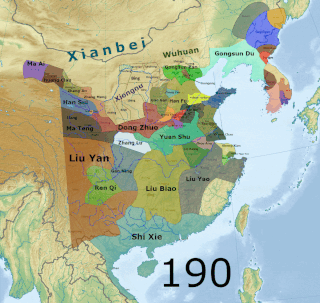| Three Kingdoms period 三國時代 | |
|---|---|
| 220–280 AD | |
 Evolution of territory controlled by Chinese states between 190 and 280 AD | |
| Location | China proper |
| Key events |
|
| Three Kingdoms | |||||||||||||||||||||||||||
|---|---|---|---|---|---|---|---|---|---|---|---|---|---|---|---|---|---|---|---|---|---|---|---|---|---|---|---|
| Chinese name | |||||||||||||||||||||||||||
| Traditional Chinese | 三國 | ||||||||||||||||||||||||||
| Simplified Chinese | 三国 | ||||||||||||||||||||||||||
| Hanyu Pinyin | Sānguó | ||||||||||||||||||||||||||
| |||||||||||||||||||||||||||
| Vietnamese name | |||||||||||||||||||||||||||
| Vietnamese | Tam Quốc | ||||||||||||||||||||||||||
| Hán-Nôm | 三國 | ||||||||||||||||||||||||||
| Korean name | |||||||||||||||||||||||||||
| Hangul | 삼국 | ||||||||||||||||||||||||||
| Hanja | 三國 | ||||||||||||||||||||||||||
| |||||||||||||||||||||||||||
| Japanese name | |||||||||||||||||||||||||||
| Kyūjitai | 三國 | ||||||||||||||||||||||||||
| Shinjitai | 三国 | ||||||||||||||||||||||||||
| |||||||||||||||||||||||||||
| Part of a series on the |
| History of China |
|---|
The Three Kingdoms of Cao Wei, Shu Han, and Eastern Wu dominated China from 220 to 280 AD following the end of the Han dynasty.[1] This period was preceded by the Eastern Han dynasty and followed by the Western Jin dynasty. Academically, the periodisation begins with the establishment of Cao Wei in 220 and ends with the conquest of Wu by Jin in 280. The period immediately preceding the Three Kingdoms, from 184 to 220, was marked by chaotic infighting among warlords across China as Han authority collapsed. The period from 220 to 263 was marked by a comparatively stable arrangement between Cao Wei, Shu Han, and Eastern Wu. This stability broke down with the conquest of Shu by Wei in 263, followed by the usurpation of Cao Wei by Jin in 266 and ultimately the conquest of Wu by Jin in 280.
The Three Kingdoms period including the collapse of the Han is one of the bloodiest in Chinese history. A nationwide census taken in 280, following the reunification of the Three Kingdoms under the Jin shows a total of 2,459,840 households and 16,163,863 individuals which was only a fraction of the 10,677,960 households, and 56,486,856 individuals reported during the Han era.[2] While the census may not have been particularly accurate due to a multitude of factors of the times, in 280, the Jin did make an attempt to account for all individuals where they could.[3]
Technology advanced significantly during this period. Shu chancellor Zhuge Liang invented the wooden ox, suggested to be an early form of the wheelbarrow,[4] and improved on the repeating crossbow. Wei mechanical engineer Ma Jun is considered by many to be the equal of his predecessor Zhang Heng.[5] He invented a hydraulic-powered, mechanical puppet theatre designed for Emperor Ming of Wei, square-pallet chain pumps for irrigation of gardens in Luoyang, and the ingenious design of the south-pointing chariot, a non-magnetic directional compass operated by differential gears.
The authoritative historical record of the era is Chen Shou's Records of the Three Kingdoms (c. 290 AD), in tandem with the later annotations published in 429 by Pei Songzhi. While comparatively short, the Three Kingdoms period has been romanticised in the culture of the Sinosphere. It has been retold and dramatised in folklore, opera, and novels, as well as film, television, and video games. The most well-known fictional adaptation of the history is Romance of the Three Kingdoms, a historical novel written during the Ming dynasty by Luo Guanzhong.
- ^ Theobald (2000).
- ^ Dreyer, Edward L. 2009. “Military Aspects of the War of the Eight Princes, 300–307.” In Military Culture in Imperial China, edited by Nicola Di Cosmo. Cambridge: Harvard University Press. 112–142. ISBN 978-0-674-03109-8.
- ^ Hans Bielenstein. Chinese historical demography A.D. 2-1982. Östasiatiska museet. p 17
- ^ Breverton, Terry (2013). Breverton's Encyclopedia of Inventions (Unabridged ed.). Quercus. ISBN 978-1-623-65234-0.
- ^ Yan, Hong-Sen (2007). Reconstruction Designs of Lost Ancient Chinese Machinery. Dordrecht: Springer. p. 129. ISBN 978-1-402-06460-9.